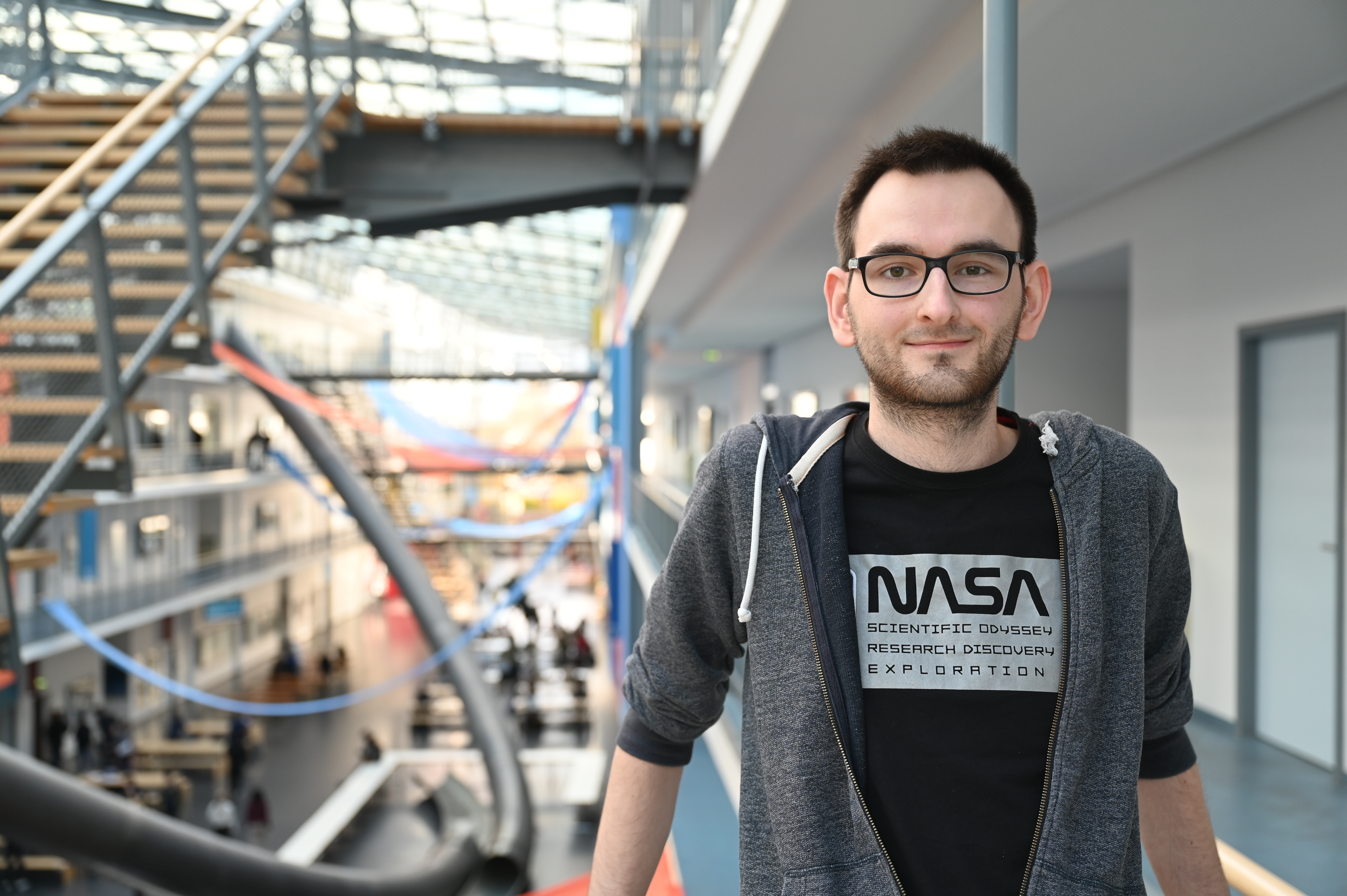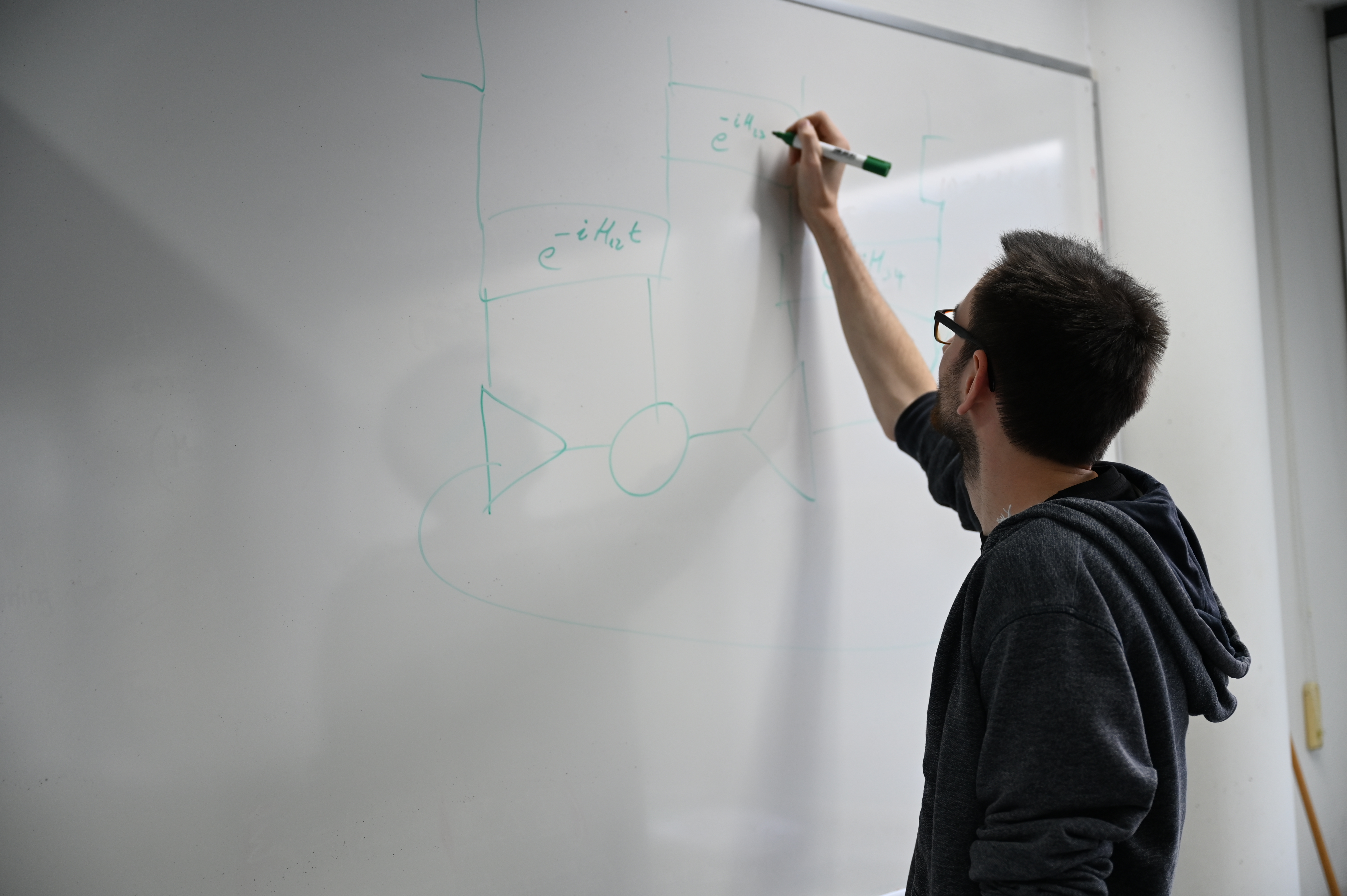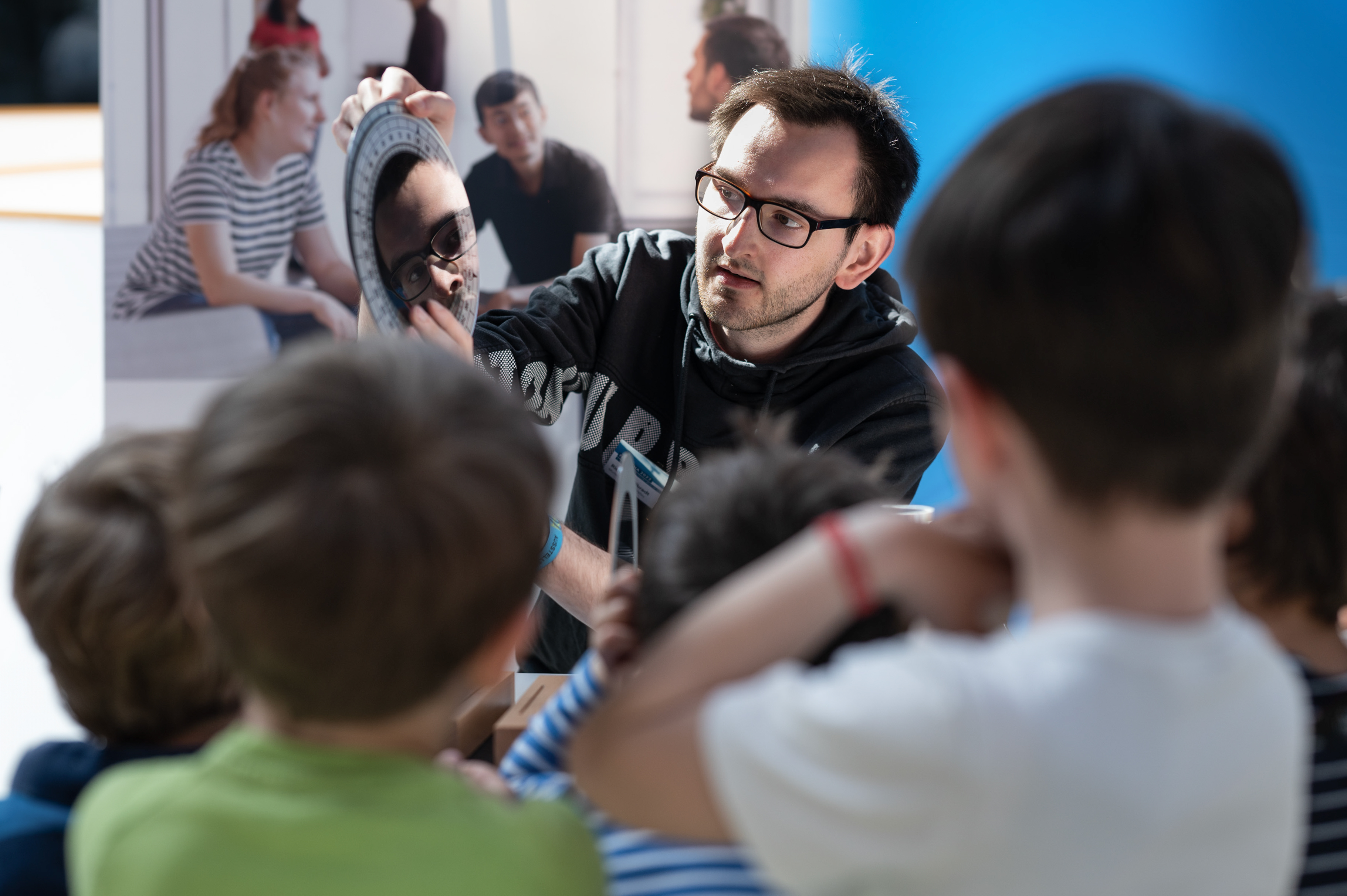"Tensor networks have become like a second language for me"
Replicating quantum computers with tensors
As early as elementary school, Richard Milbradt wanted to become a researcher – "back then, for me that meant exploring the jungle and looking at animals" – today he researches open quantum systems. Even though his workplace is a fair way from a jungle, Richard has retained his original spirit of exploration.
By Veronika Früh
Richard Milbradt leads the way through the light-flooded Magistrale, the heart of the TUM School of Computation, Information and Technology (CIT) on the Garching research campus. A quick glance at the famous parabolic slide, then he turns into the corridor with his office. The 25-year-old doctoral student has been researching the simulation of open quantum systems with tensor networks here for almost two years.
When Richard came to Munich after completing his Bachelor's degree in physics at Heinrich Heine University in Düsseldorf to enrole for the elite Master's degree course in "Theoretical and Mathematical Physics" at Ludwig-Maximilians-Universität München and TU Munich, he actually wanted to focus on particle physics and astrophysics – "in other words, what most people imagine when they start studying physics," he explains. "To win the next Nobel Prize for the theory of relativity," he adds with a laugh. But he quickly realized that he didn't enjoy it at all. "But I thought the lecture on quantum information was great!" So much so that he immediately wanted to do a second Master's degree in Quantum Science & Technology. However, a professor advised him to go straight for a doctorate, and the job opening with Christian Mendl, the same professor with whom Richard had already written his Master's thesis, came at just the right time.
"You get a graphical expression for something that is physics"
The doctoral student finds simple words for his work with tensor-network methods: "I'm basically doing what I used to do a lot as a child – playing with Lego." Tensor networks allow for the theoretical analysis of quantum information in many-body systems. "You can write this down using mathematical formulas, or you can make life easy for yourself and draw funny symbols," Richard explains.
He draws circles, triangles, and squares on a whiteboard, filling them with formulas and connecting them with lines. As with Lego, one building block alone is still pretty boring. But the more building blocks you put together, the more exciting it gets. "And if you put a lot of tensors together, you no longer just get mathematical things that contain a lot of numbers, but a graphical expression of something that is physics," the doctoral student enthuses. After all, a picture is worth a thousand words. And a tensor network diagram says as much as a page of formulas. "But beautifully presented," says Richard.

Richard Milbradt, 25
Position
Ph.D. student
Institute
Chair of Scientific Computing
HAT
Degree
Theorethical and Mathematical Physics
Richard researches open quantum systems in order to understand how quantum systems react when they interact with the environment. To simulate the systems, he works with so-called tensor networks, a graphical representation.

As soon as he starts talking about tensor networks, Richard's eyes light up and the previously quiet Ph.D. student comes alive as he draws symbols and lines in the air with his hands to emphasize his explanations. You can tell that this is a person who has found exactly the right topic for himself. "To me, this is exactly what it looks like in a quantum mechanical system," Richard confirms his personal enthusiasm for the subject. "Tensors are a very good way to see what happens quantum mechanically without needing a lot of math." He can now draw huge diagrams by hand from his head: "This process, the fact that it has now become a second language for me, is a lot of fun," he says happily.
Simulating quantum computers
In addition to the fun that Richard personally has with tensor networks, they also have practical benefits for quantum computing. Tensors can be used to theoretically describe quantum systems in such a way that they can be recreated and simulated on a computer, with certain restrictions. For example, qubits can be represented as individual tensors with small legs. If several previously independent qubits are connected at the legs after the experiment, they have been entangled.
The doctoral student first puts his ideas down on paper in the traditional way, draws tensor networks, "scribbles around" until he can see whether this can solve a new problem. Then comes the programming: "The idea is to simulate quantum systems with tensor networks, and I have to write the computer code to do it." Translating his handwritten notes into something that a computer can understand is anything but trivial. "Computers are actually really stupid," Richard laughs, "and when testing, it usually turns out that the computer didn't understand what I was trying to tell it." Then it's a matter of tweaking the code until it works. In the best-case scenario, Richard can then apply the code to an interesting physical system.
Researching interactions of quantum systems with the environment
Richard is particularly interested in simulating open quantum systems. Open – that means there is interaction with the environment. "I find it exciting to get away from the simple idea that you had in your undergraduate quantum mechanics class," the doctoral student explains. "I look at what it's like when the system is not completely closed, but more realistic."
For him, one of the driving forces is the excessive and sometimes esoteric use of the quantum concept: "Quantum mechanics, as you find it in popular scientific literature, only works if you look at a single particle in complete isolation. It no longer works on the scale of humanity. That's why something like quantum healing is automatically absolute nonsense." However, the doctoral student wants to find out what actually happens when quantum particles interact with each other inside and outside a system.
Fighting misconceptions about quantum physics
That quantum mechanics cannot work in the same way as in the movie "Ant Man", for example, is obvious. Richard takes a deep breath: when the movie was released, he and his fellow students agreed not to talk about it in terms of physics. "Everything that was said about quantum physics was complete nonsense," he blurts out. The problem is that when people are exposed to the subject only through movies like this, they completely misunderstand it.

That is one of the reasons why the physicist is involved in formats that bring quantum physics to a wider audience. With the student initiative "PushQuantum", for example, he explained what quantum technologies can do at the Quantum Days in the Science Communications Lab of the Deutsches Museum, and at the science fair "FORSCHA" he was active at the MQV booth. "I enjoy that because you can talk to people who are at least a little bit interested in my topic. I also came to this topic at some point because I was simply interested in it," says Richard. At the same time, it makes him adopt a different perspective: "When you start studying physics, maths or computer science, your brain is programmed in the first two semesters to think in a different, more analytical way. And when you talk to people, you have to go back again." However, this balancing act of remaining understandable and at the same time "not talking nonsense" became increasingly easy for him with more practice.
Richard also has a simple solution to the misrepresentation of quantum physics in films: "I can settle for saying it's magic." The physicist also talks briefly about magic when it comes to his last two years at school, which he spent at a boarding school in England. Which, he can confirm, had a lot in common with Hogwarts, the famous wizard school from Harry Potter. "We had an old dining hall, without flying candles, but with shields on the wall," he says. The separate houses for boys and girls, who competed against each other in sports at the end of each term, also fit the stereotype.
Richard has fond memories of his time in England and life at boarding school, which was very different from his life in Germany. "School really was the center of attention there, not only academically, but also in terms of leisure activities. It sounds cheesy now, but it broadened my horizons." His stay at King's College Taunton in Somerset was actually only planned for one year. However, as his parents had moved in the meantime and Richard didn't want to transfer to another high school for his A-levels, he stayed in England for his degree before returning to Düsseldorf to start his Bachelor's degree.
Even though Richard would prefer his old home Düsseldorf to Munich, he really enjoys living just a short train ride away from the mountains. When the weather is too bad for hiking, he also likes to go climbing or bouldering with colleagues from his department – he wonders whether you're a real physicist without these hobbies.
Close interdisciplinary collaboration
The fact that he also spends a lot of time with his colleagues in his free time speaks volumes about the good relationship that exists within the group. There is a simple explanation for this: the joint coffee break every day at half past two, where cakes are brought for all kinds of events. "I think this relaxed atmosphere characterizes the chair a bit. People are very friendly with each other," says Richard, emphasizing how lucky he is to be there. His standard cake recipe: marble or red-wine cake.
Of course, it's not just the good cake that Richard appreciates about his group. He also benefits from the close scientific collaboration: "We have physicists, we have mathematicians, and we have computer scientists. Everyone has different knowledge and we intersect in quantum computing." Munich Quantum Valley offers him a good interdisciplinary network – in his group alone, members from four different MQV consortia are represented, so the exchange is practically self-evident.
Richard sees a particular advantage in the close proximity to the experimental physicists in Garching. "We have a direct line to the people at the Max Planck Institute of Quantum Optics or the people at the Walther Meißner Institute, who are building their quantum computers there." This is very practical, he says, as you can simply ask which physical systems the colleagues are working with and try out your own code using their parameters. "At some point, it goes the other way around when we simulate something for our colleagues," Richard explains. "Admittedly, we're not quite there yet. But that would be the next step."
Published 28 March 2024; Interview 10 November 2023